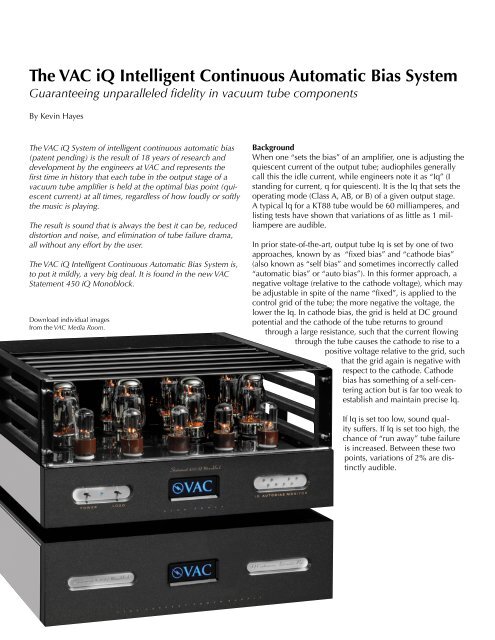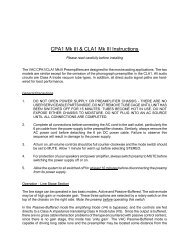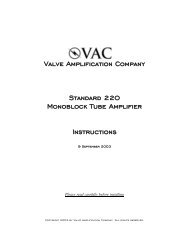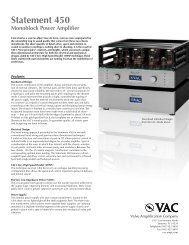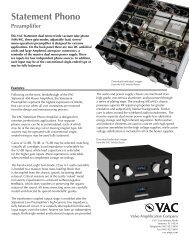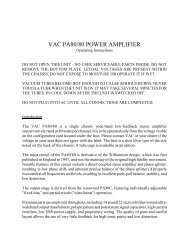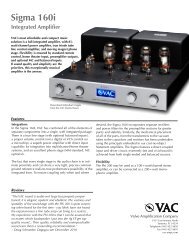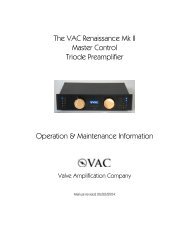The VAC iQ Intelligent Continuous Automatic Bias System
The VAC iQ Intelligent Continuous Automatic Bias System
The VAC iQ Intelligent Continuous Automatic Bias System
You also want an ePaper? Increase the reach of your titles
YUMPU automatically turns print PDFs into web optimized ePapers that Google loves.
<strong>The</strong> <strong>VAC</strong> <strong>iQ</strong> <strong>Intelligent</strong> <strong>Continuous</strong> <strong>Automatic</strong> <strong>Bias</strong> <strong>System</strong><br />
Guaranteeing unparalleled fidelity in vacuum tube components<br />
By Kevin Hayes<br />
<strong>The</strong> <strong>VAC</strong> <strong>iQ</strong> <strong>System</strong> of intelligent continuous automatic bias<br />
(patent pending) is the result of 18 years of research and<br />
development by the engineers at <strong>VAC</strong> and represents the<br />
first time in history that each tube in the output stage of a<br />
vacuum tube amplifier is held at the optimal bias point (quiescent<br />
current) at all times, regardless of how loudly or softly<br />
the music is playing.<br />
<strong>The</strong> result is sound that is always the best it can be, reduced<br />
distortion and noise, and elimination of tube failure drama,<br />
all without any effort by the user.<br />
<strong>The</strong> <strong>VAC</strong> <strong>iQ</strong> <strong>Intelligent</strong> <strong>Continuous</strong> <strong>Automatic</strong> <strong>Bias</strong> <strong>System</strong> is,<br />
to put it mildly, a very big deal. It is found in the new <strong>VAC</strong><br />
Statement 450 <strong>iQ</strong> Monoblock.<br />
Download individual images<br />
from the <strong>VAC</strong> Media Room.<br />
Background<br />
When one “sets the bias” of an amplifier, one is adjusting the<br />
quiescent current of the output tube; audiophiles generally<br />
call this the idle current, while engineers note it as “Iq” (I<br />
standing for current, q for quiescent). It is the Iq that sets the<br />
operating mode (Class A, AB, or B) of a given output stage.<br />
A typical Iq for a KT88 tube would be 60 milliamperes, and<br />
listing tests have shown that variations of as little as 1 milliampere<br />
are audible.<br />
In prior state-of-the-art, output tube Iq is set by one of two<br />
approaches, known by as “fixed bias” and “cathode bias”<br />
(also known as “self bias” and sometimes incorrectly called<br />
“automatic bias” or “auto bias”). In this former approach, a<br />
negative voltage (relative to the cathode voltage), which may<br />
be adjustable in spite of the name “fixed”, is applied to the<br />
control grid of the tube; the more negative the voltage, the<br />
lower the Iq. In cathode bias, the grid is held at DC ground<br />
potential and the cathode of the tube returns to ground<br />
through a large resistance, such that the current flowing<br />
through the tube causes the cathode to rise to a<br />
positive voltage relative to the grid, such<br />
that the grid again is negative with<br />
respect to the cathode. Cathode<br />
bias has something of a self-centering<br />
action but is far too weak to<br />
establish and maintain precise Iq.<br />
If Iq is set too low, sound quality<br />
suffers. If Iq is set too high, the<br />
chance of “run away” tube failure<br />
is increased. Between these two<br />
points, variations of 2% are distinctly<br />
audible.
Operation<br />
If tubes were perfectly stable devices, one could set the bias<br />
once and never think of it again. In practice, the Iq of a tube<br />
varies with warm-up, with power line voltage, with the temperature<br />
of the output transformer, with age, with the volume<br />
of music being played through it, and randomly. Some of the<br />
variations are minor, and some happen over long periods<br />
of time, but one way or another, Iq should be watched and<br />
adjusted, both as a matter of sound quality and reliability.<br />
<strong>The</strong> Difficulty<br />
At first, this would seem like an easy problem to solve: just<br />
have an automatic circuit keep measuring the DC and adjust<br />
it all the time. <strong>The</strong> problem is that no conventional technique<br />
allows for this because of a characteristic of the tube called<br />
the “rectification effect”. Even though a vacuum tube is much<br />
more linear than a transistor, it is not perfectly linear, and that<br />
small nonlinearity causes part of the audio signal to appear<br />
as a DC component when you try to measure Iq while music<br />
is playing. This is the rectification effect, and it is inherent in<br />
all existing amplifying devices (tube and transistor) to some<br />
degree and is quite extreme whenever a tube reaches cut-off,<br />
as happens in all Class AB and Class B amplifiers as well as<br />
when an amplifier reaches it maximum power output (i.e.,<br />
when it “clips”).<br />
Many approaches were explored at <strong>VAC</strong>. One of the most<br />
appealing at first blush was to measure the DC plus audio<br />
signal and then subtract the measured audio signal from it,<br />
on the theory the (DC + AC) – AC = DC. As it turns out, this<br />
does not work due to the fact that musical waveforms are<br />
asymmetrical, and the location of the waveform’s true zero<br />
crossing, which is lost when the DC is removed, changes the<br />
measured RMS value of the energy present.<br />
Other Approaches / Prior Art<br />
Some other approaches to automatic bias have been tried, and<br />
there are some amplifiers that do not have bias adjustments<br />
and thus seems automatic. <strong>The</strong> most prominent of these are<br />
now briefly summarized.<br />
1) Cathode bias. As previously noted, cathode bias provides<br />
some inherent correction, steering the Iq toward a desired<br />
point, but without the strength of action and precision needed.<br />
<strong>The</strong>re is a second problem caused by the bypass capacitor<br />
which must by used around the cathode resistor, which is<br />
that it is charged up by any present rectification effect. <strong>The</strong><br />
result is that when the amplifier enters Class AB operation<br />
or is clipped, the capacitor charges to a higher voltage; the<br />
bias voltage rises and the Iq is reduced, driving the amplifier<br />
toward Class B operation, and in some cases, beyond, with<br />
very high resulting distortion. Under some circumstances, the<br />
amplifier will produce high distortion for several seconds after<br />
it exits clipping.<br />
2) Some designers have placed a constant current source<br />
in place of a cathode bias’s cathode resistor. Unfortunately,<br />
cathode current must vary for amplification to take place, and<br />
in the end, the same basic problem with rectification effect<br />
occurs.<br />
3) Some designers run their output stage very close to Class<br />
B, with Iq in the 10-20 milliampere range. Part of the theory<br />
here is that even if the tube drifts, it is unlikely to drift so far as<br />
to cause a catastrophic tube failure. Of course, operation isn’t<br />
really optimized, and Class B operation has some significant<br />
sonic penalties. In some amplifiers, massive amounts of negative<br />
feedback are used to lower measured distortion; in others,<br />
things like DC restorers and other older techniques are applied<br />
in attempt to reduce the distortion somewhat, to small effect.
4) A few manufacturers use an active circuit, usually a<br />
“set and hold” logic controller, to set bias during the amplifier’s<br />
turn-on cycle, and then hold that setting thereafter.<br />
<strong>The</strong> problem, as anyone who has adjusted a tube amplifier<br />
knows, is that a tube’s idle current changes a lot within the<br />
first half hour of operation. Thus, an amplifier that employs<br />
this type of “automatic self-regulation” is guaranteed never to<br />
be operating optimally. Due to this fact, additional protection<br />
circuits are added to detect tubes that run away due to the<br />
lack of continuous automatic bias optimization.<br />
5) As a side note, in the world of solid-state amplifiers, one<br />
often encounters adaptive sliding bias schemes. In such cases,<br />
the designer is not attempting to hold an optimal, steady<br />
Iq, but rather is intentionally varying it, trying to prevent cutoff<br />
from occurring for more than a fraction of a second at a<br />
time, effectively keeping the amplifier as close to a Class B Iq<br />
as possible while still being able to claim some sort of Class<br />
A operation. This is altogether different than the intention or<br />
operation of the <strong>VAC</strong> circuit.<br />
<strong>The</strong> <strong>VAC</strong> <strong>iQ</strong> <strong>Intelligent</strong> <strong>Continuous</strong> <strong>Automatic</strong> <strong>Bias</strong> <strong>System</strong><br />
After sixteen years of research, <strong>VAC</strong> reached the conclusion<br />
that is was not mathematically possible to achieve an<br />
automatic bias circuit that was theoretically precise. It was<br />
at that point that a new insight arose, giving rise to a new<br />
heuristic approach. Two additional years of research, modeling,<br />
experimentation, and testing proved that <strong>VAC</strong>’s heuristic<br />
approach results in an underlying Iq in each tube that is<br />
always within 1% of the set target Iq under all conditions,<br />
from silent passages to the most explosive and sustained<br />
musical peaks, and in the process, ensures that the individual<br />
tubes as well as the overall output stage are always delivering<br />
optimal performance.<br />
<strong>The</strong> <strong>VAC</strong> <strong>iQ</strong> <strong>Continuous</strong> <strong>Automatic</strong> <strong>Bias</strong> <strong>System</strong> (patent pending)<br />
is a true breakthrough in power amplifier design. It is not<br />
inexpensive, but, once heard, it is indispensable.<br />
What Else Does It Do?<br />
In addition to guaranteeing unparalleled fidelity, the <strong>VAC</strong> <strong>iQ</strong><br />
<strong>System</strong> greatly enhances the reliability of the amplifier in<br />
several ways.<br />
First, “run away” tube failures are eliminated. Run away<br />
tubes arise from one of two mechanisms. <strong>The</strong> first is a “gassy”<br />
tube, the Iq of which tends to rise on its own until it goes into<br />
positive thermal feedback; the <strong>VAC</strong> <strong>iQ</strong> <strong>System</strong> prevents that<br />
cycle from ever starting. Interestingly, through observation of<br />
the operation of the <strong>VAC</strong> <strong>iQ</strong> circuit, it has been revealed that<br />
such tubes actually tend to be relatively “cold” tubes, which<br />
users ordinarily “crank up” thorough bias adjustment.<br />
<strong>The</strong> second run away mode occurs when a tube is set to run<br />
at a relatively high <strong>iQ</strong> and then randomly drifts a bit higher<br />
or becomes physically hotter through sustained loud musical<br />
passages. <strong>The</strong> <strong>VAC</strong> <strong>iQ</strong> circuit detects any move to a higher<br />
<strong>iQ</strong> and automatically corrects for it, and once again, the run<br />
away cycle is never allowed to start.<br />
As part of its operation, the <strong>VAC</strong> <strong>iQ</strong> <strong>System</strong> can tell when a<br />
tube is becoming weak and notifies the user that it should be<br />
replaced when convenient, while still making the best of its<br />
remaining life.<br />
Lastly, it is always possible for a mechanical break to occur<br />
within a tube, resulting in an internal short circuit. No adjustment<br />
of bias can fix this, so if this occurs, the <strong>VAC</strong> <strong>iQ</strong> <strong>System</strong><br />
automatically shuts off the high voltage power supply within<br />
a fraction of a second, long before a conventional fuse could<br />
blow, and illuminates a red LED to indicate which tube has<br />
failed.<br />
Summary<br />
<strong>The</strong> <strong>VAC</strong> <strong>iQ</strong> <strong>Intelligent</strong> <strong>Continuous</strong> <strong>Automatic</strong> <strong>Bias</strong> <strong>System</strong><br />
advantages:<br />
- Always the best sound<br />
-No user adjustment<br />
- Supreme reliability<br />
-Longer tube life<br />
-Indication of weak tubes<br />
-<strong>Automatic</strong> protection from and indication of failed tubes<br />
Final Note<br />
<strong>The</strong> principles of the <strong>VAC</strong> circuit are applicable to solid-state<br />
devices as well as vacuum tubes. Development and licensing<br />
of these applications will be considered.<br />
<strong>VAC</strong><br />
<strong>VAC</strong><br />
Valve Amplification Company<br />
1911 East Avenue North<br />
Sarasota, FL 34234<br />
Telephone (941) 952 9695<br />
Fax (941) 952 9691<br />
vac-amps.com


